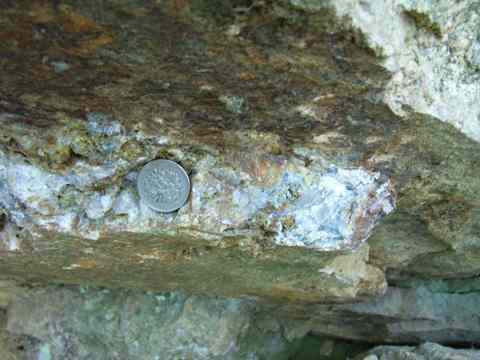Otani Mine, Hankei Shaft
Rokuya, Hiedano village, Kameoka city, Kyoto, Japan
Synonym
Mount Gyoja
Occurrence
Sn-W Pneumatolytic deposit formed by intrusion of the Late Cretaceous (95 Ma) Gyojayama Granodiorite in the Middle Jurassic (170 Ma) Kuroi Unit, an upper member of the Tamba accretionary complex. The Gyojayama Granodiorite is S-type (Ilmenite-series). The Kuroi Unit corresponds to the Kanayama Unit of the Tamba-Mino-Ashio accretionary complex. Ages of sedimentary rocks were determined by radiolarians, and granite by K-Ar radiometric dating.

Outcrop of cassiterite- and scheelite-bearing pneumatolytic deposit in the Gyojayama Granodiorite. The scale coin is on the laterally elongated quartz vein, the gangue of the deposit. Both sides of the vein are the host granodiorite.
Reported Minerals
- Silver
- Copper
- Bismuth
- Pyrite
- Chalcopyrite
- Stannite
- Arsenopyrite
- Pyrrhotite
- Galena
- Bismuthinite
- Chalcocite
- Covellite
- Sphalerite
- Fluorite
- Cassiterite
- Varlamoffite
- Goethite
- Hematite
- Tungstite
- Hydrotungstite
- Cuprotungstite
- Russellite
- Calcite
- Malachite
- Jarosite
- Beudantite
- Gypsum
- Serpierite
- Wolframite
- Strolzite
- Raspite
- Scheelite
- Scorodite
- Witherite
- Parasymplesite
- Bertrandite
- Beryl
- Muscovite
Mineral Assemblages
- Quartz - Sphalerite - Stannite
- Quartz - Cassiterite - Varlamoffite
- Quartz - Chalcopyrite - Sphalerite
- Quartz - Scheelite - Tungstite - Hydrotungstite - Strolzite - Raspite
- Quartz - Beryl - Bertrandite
History
- Around 1900: Began to mine for copper.
- 1914: Began to mine tungsten.
- 1945: Temporaly stopped mining because of the end of World War II.
- 1951: Restarted to mine for tungsten.
- 1983: Closed.
Locality
- Takatori Mine (Ferberite)
- Ebisu Mine (Wolframite)
- Togane Mine (Wolframite)
- Komaki Mine (Wolframite)
- Itaga Mine (Andalusite)
- Otani Mine (Cassiterite, Scheelite)
- Taisho Mine (Cassiterite)
- Ichiyanagi Mine (Löllingite)
- Takane Mine (Bismuth)
- Karasawa Mine (Bismuth)
- Takemori (Dravite)